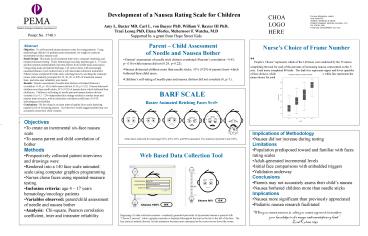Development of a Nausea Rating Scale for Children - PowerPoint PPT Presentation
1 / 1
Title:
Development of a Nausea Rating Scale for Children
Description:
Development of a Nausea Rating Scale for Children ... Initial face comparisons with embedded triggers. Validation underway. Conclusions ... – PowerPoint PPT presentation
Number of Views:59
Avg rating:3.0/5.0
Title: Development of a Nausea Rating Scale for Children
1
Development of a Nausea Rating Scale for Children
For more information, contact Amy Baxter
MD Childrens Healthcare of Atlanta Pediatric
Emergency Medicine Associates - LLC Tel.
678-344-1960 E-mail amy_baxter_at_PEMA-LLC.com
CHOA LOGO HERE
Amy L. Baxter MD, Carl L. von Baeyer PhD, William
V. Baxter III PhD, Traci Leong PhD, Elena
Morles, Mehernoor F. Watcha, M.D Supported by a
grant from Hope Street Kids
Poster No. 3748.3
Abstract Objective No self-reported nausea
measure exists for young patients. Using
methodology effective in pediatric pain
assessment, we sought to create an incremental
six-face nausea scale. Study Design This study
involved patient interviews, computer rendering,
and repeated-measure testing. Thirty
hematology/oncology patients ages 4 - 17 years
and their parents independently reported distress
from needle sticks and nausea. Using rating
tasks and patient drawings, 140 cartoon faces
with increasingly nauseated features were
rendered into a web-based data collection
instrument. Fifteen nurses completed 80 trials
each, selecting faces by scrolling the computer
mouse when randomly prompted for 20, 40, 60, or
80 of maximum nausea. Inter- and intra-rater
reliability were tested. Results Parents
assessment of needle stick distress correlated
(Pearsons correlation 0.45, p.016) while
nausea did not (0.24, p0.22). Nausea distressed
children more than needle sticks 31 (9/29) of
parents knew which bothered their child more.
Childrens self-rating of needle pain and nausea
distress did not correlate (0, p1). 1200
independent face ratings resulted in similar mean
and median interval scores, with an intraclass
correlation coefficient of 0.819, indicating good
reliability. Conclusions We developed a
six-item interval-quality faces scale depicting
regular levels of increasing nausea. Our
interview results suggest parents may not
accurately assess their childs nausea.
Parent Child Assessment of Needle and Nausea
Bother
Nurses Choice of Frame Number
Peoples Choice represents which of the 140
faces were endorsed by the 15 nurses completing
the task for each of the percents of increasing
nausea, represented on the X axis. Each nurse
completed 80 trials. The dark box represents
upper and lower quartiles of face choices, while
the whiskers represent entire range. The while
line represents the mean choice for each
intermediate face/nausea percentile.
- Parents assessment of needle stick distress
correlated (Pearsons correlation 0.45, p.016)
while nausea did not (0.24, p0.22). - Nausea distressed children more than needle
sticks 31 (9/29) of parents knew which bothered
their child more. - Childrens self-rating of needle pain and nausea
distress did not correlate (0, p1).
BARF SCALE Baxter Animated Retching Faces Scale
early out
sit
with
- Objectives
- To create an incremental six-face nausea scale
- To assess parent and child correlation of bother
- Methods
- Prospectively collected patient interviews and
drawings were - Rendered into a 140 face scale animated scale
using computer graphics programming - Nurses chose faces using repeated-measure testing
- Inclusion criteria age 4 17 years
hematology/oncology patients - Variables observed parent/child assessment of
needle and nausea bother - Analysis Chi-square, Pearson correlation
coefficient, inter and intrarater reliability.
A
B
- Implications of Methodology
- Nausea did not increase during testing
- Limitations
- Population predisposed toward and familiar with
faces rating scales - Adult-generated incremental levels
- Initial face comparisons with embedded triggers
- Validation underway
- Conclusions
- Parents may not accurately assess their childs
nausea. - Nausea bothered children more than needle sticks
- Implications
- Nausea more significant than previously
appreciated - Pediatric nausea research facilitated
- When you cannot measure it, when you cannot
express it in numbers, - your knowledge is of a meager and unsatisfactory
kind. - -Lord Kelvin, 1893
Mean faces endorsed for each target 20, 40,
60, and 80 nauseated. Two anchors represent 0
and 100.
Web Based Data Collection Tool
Beginning of a data collection measure a
randomly generated percentile of represented
nausea is queried with Choose X percent, while
a graphic reminder is displayed throughout the
trial on the bar to the left of the face. The
face starts as neutral (shown), but the animation
becomes more nauseated as the cursor moves down
the screen.































